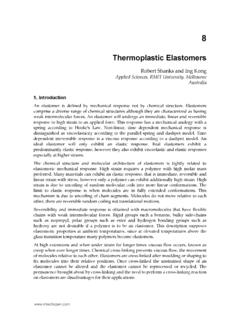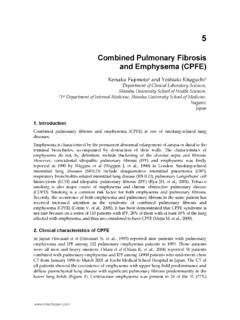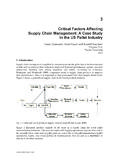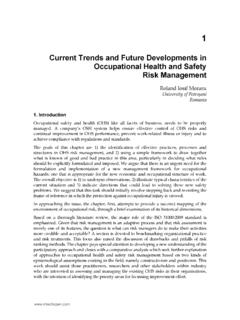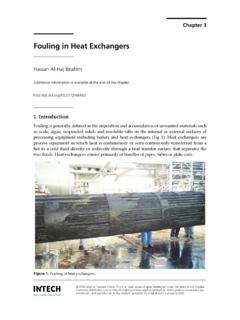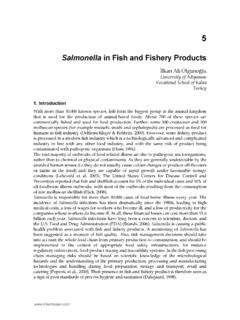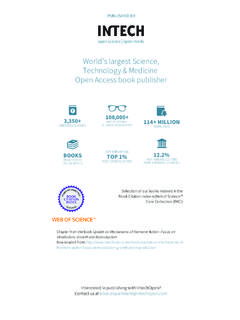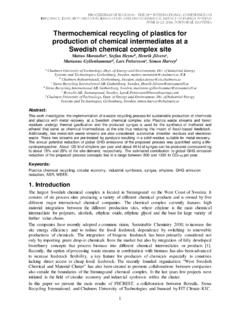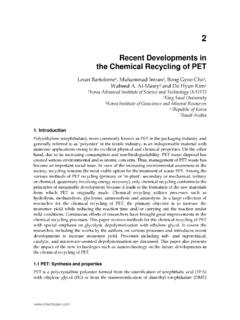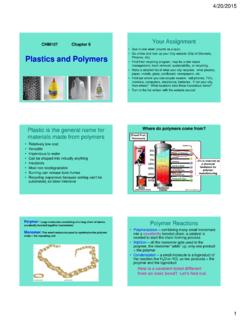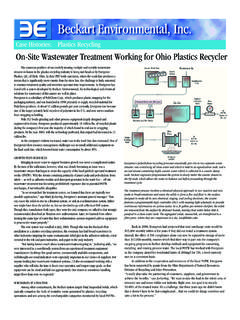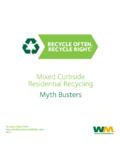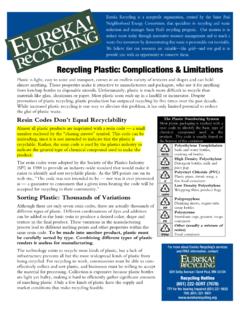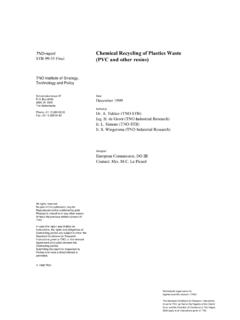Transcription of Recent Advances in the Chemical Recycling of Polymers (PP ...
1 1 Recent Advances in the Chemical Recycling of Polymers (PP, PS, LDPE, HDPE, PVC, PC, Nylon, PMMA) Dimitris S. Achilias et al.* Laboratory of Organic Chemical Technology, Department of Chemistry, Aristotle University of Thessaloniki, Thessaloniki Greece 1. Introduction During last decades, the great population increase worldwide together with the need of people to adopt improved conditions of living led to a dramatical increase of the consumption of Polymers (mainly plastics ). The world s annual consumption of plastic materials has increased from around 5 million tones in the 1950s to nearly 100 million tones today. Since the duration of life of plastic wastes is very small (roughly 40% have duration of life smaller than one month), there is a vast waste stream that reaches each year to the final recipients creating a serious environmental problem.
2 The presently most common practice of handling such waste streams is to incinerate them with energy recovery or to use them for land-filling. Disposing of the waste to landfill is becoming undesirable due to legislation pressures (waste to landfill must be reduced by 35% over the period from 1995 to 2020), rising costs and the poor biodegradability of commonly used Polymers (Achilias et al., 2009). Therefore, Recycling seems to be the best solution. The Recycling of waste Polymers can be carried out in many ways. Four main approaches have been proposed presented in Scheme 1 (Karayannidis and Achilias, 2007; Scheirs, 1998): 1. Primary Recycling refers to the in-plant Recycling of the scrap material of controlled history.
3 This process remains the most popular as it ensures simplicity and low cost, dealing however only with the Recycling of clean uncontaminated single-type waste. 2. Mechanical Recycling (or secondary Recycling ). In this approach, the polymer is separated from its associated contaminants and it can be readily reprocessed into granules by conventional melt extrusion. Mechanical Recycling includes the sorting and separation of the wastes, size reduction and melt filtration. The basic polymer is not altered during the process. The main disadvantage of this type of Recycling is the deterioration of product properties in every cycle. This occurs because the molecular weight of the * Lefteris Andriotis, Ioannis A.
4 Koutsidis, Dimitra A. Louka, Nikolaos P. Nianias, Panoraia Siafaka, Ioannis Tsagkalias and Georgia Tsintzou Laboratory of Organic Chemical Technology, Department of Chemistry, Aristotle University of Thessaloniki, Thessaloniki, Greece Material Recycling Trends and Perspectives 4 recycled resin is reduced due to chain scission reactions caused by the presence of water and trace acidic impurities. Strategies for maintaining the polymer average molecular weight during reprocessing include intensive drying, reprocessing with degassing vacuum, the use of chain extender compounds, etc. 3. Chemical or Feedstock Recycling (tertiary Recycling ) has been defined as the process leading in total depolymerization of PET to the monomers, or partial depolymerization to oligomers and other Chemical substances.
5 The monomers could subsequently re-polymerized to regenerate the original polymer . 4. Energy recovery (Quaternary Recycling ) refers to the recovery of plastic s energy content. Incineration aiming at the recovery of energy is currently the most effective way to reduce the volume of organic materials. Although Polymers are actually high-yielding energy sources, this method has been widely accused as ecologically unacceptable owing to the health risk from air born toxic substances dioxins (in the case of chlorine containing Polymers ). Apart from the aforementioned methods, direct reuse of a plastic material ( PET) could be considered as a zero order Recycling technique (Nikles and Farahat, 2005).
6 In a lot of countries it is a common practice PET-bottles to refilled and reused. However, this should be done with a great care since plastic bottles are more likely than glass to absorb contaminants that could be released back into food when the bottle is refilled. Moreover, refill of a PET-bottle with a high-alcoholic-degree drink may lead to degradation of the macromolecular chains with unexpected results. Scheme 1. polymer Recycling Techniques. The objective of a plastic management policy, in accordance with the principles of sustainable development (development that meets the needs of present generation without compromising the ability of future generations to meet their needs), should be not only the reuse of polymeric materials but also the production of raw materials (monomers), from which they could be reproduced, or other secondary valuable products, Advances in the Chemical Recycling of Polymers (PP, PS, LDPE, HDPE, PVC, PC, Nylon, PMMA) 5 which could be useful as feedstock for a variety of downstream industrial processes or as transportation fuel.
7 In this sense, among the techniques proposed for Recycling of waste Polymers the most challenging method is Chemical or feedstock Recycling and various technologies have been successfully demonstrated and continue to be developed (Achilias and Karayannidis, 2004). The aim of this chapter is to provide a critical review of the methods proposed and/or applied during mainly the last decade, on the Chemical Recycling of Polymers . In this way, the state-of-the-art of the Chemical Recycling methods of several Polymers will be presented. Polymers that will be studied include the widely used plastics , based on poly(ethylene terephthalate) (PET), polypropylene (PP), polystyrene (PS), low density polyethylene (LDPE), high density polyethylene (HDPE), poly(vinyl chloride) (PVC), polycarbonate (PC), poly(methyl methacrylate) (PMMA) and nylon.
8 2. Chemical Recycling of poly(ethylene terephthalate) PET PET is a polyester with functional ester groups that can be cleaved by some reagents, such as water (hydrolysis), alcohols (alcoholysis), acids (acidolysis), glycols (glycolysis), and amines (aminolysis). Thus, Chemical Recycling processes for PET are divided as follows: (i) Hydrolysis, (ii) Glycolysis, (iii) Methanolysis and (iv) other processes (Scheme 2). According to the reagent used different products are obtained (Karayannidis and Achilias, 2007; Karayannidis et al. 2006; Karayannidis et al., 2005; Karayannidis et al. 2002; Kosmidis et al., 2001). The different process options for Chemical Recycling of PET waste may be categorized as follows: (i) regeneration of base monomers (methanolysis for dimethyl terephthalate (DMT) and hydrolysis for producing pure Terephthalic acid (TPA) and ethylene glycol (EG)); (ii) conversion into oligomers (glycolysis or solvolysis); (iii) use of glycolyzed waste for value-added products; (iv) conversion into speciality chemicals by aminolysis or ammonolysis; (v) conversion into speciality intermediates for use in plastics and coatings.
9 Scheme 2. Chemical Recycling techniques of PET. Material Recycling Trends and Perspectives 6 Recently, Recycling of PET using hydrolysis, glycolysis and aminolysis under microwave irradiation has been proposed (Achilias et al., 2010; Achilias et al., 2011; Siddiqui et al., 2010). PET Recycling in a microwave reactor has been proved a very beneficial method resulting not only in material recovery but also in substantial energy saving. This section will not be presented in detail here because it is the subject of another chapter of this book. Interested reader can find extensive details on the techniques used for the Chemical Recycling of PET in several Recent review papers appeared in literature (Scheirs, 1998; Karayannidis and Achilias, 2007).
10 3. Chemical Recycling of polypropylene Introduction Condensation Polymers like PET or Nylon, can undergo chemolysis with different reagents to produce mainly the monomers from which they have been produced or other oligomers. In contrast, vinyl Polymers , such as polyolefins (PP and PE) cannot be degraded with simple chemicals to their monomers due to the random schission of the C-C bonds. Two main Chemical Recycling routes are the thermal and catalytic degradation of these Polymers . In thermal degradation, the process produces a broad product range and requires high operating temperatures, typically more than 500 C and even up to 900 C. Thermal cracking of polyethylene and polypropylene is usually carried out either in high temperatures (>700 C), to produce an olefin mixture (C1 C4) and aromatic compounds (mainly benzene, toluene and xylene) or in low temperature (400 500 C) (thermolysis) where three fractions are received: a high-calorific value gas, condensable hydrocarbon oil and waxes.
